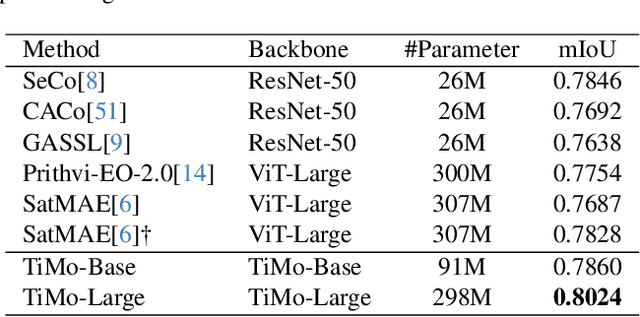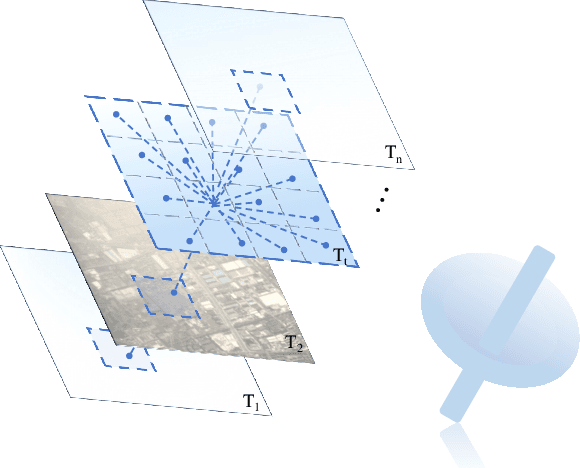Liangpei Zhang
Advancing Weakly-Supervised Change Detection in Satellite Images via Adversarial Class Prompting
Aug 24, 2025



Abstract:Weakly-Supervised Change Detection (WSCD) aims to distinguish specific object changes (e.g., objects appearing or disappearing) from background variations (e.g., environmental changes due to light, weather, or seasonal shifts) in paired satellite images, relying only on paired image (i.e., image-level) classification labels. This technique significantly reduces the need for dense annotations required in fully-supervised change detection. However, as image-level supervision only indicates whether objects have changed in a scene, WSCD methods often misclassify background variations as object changes, especially in complex remote-sensing scenarios. In this work, we propose an Adversarial Class Prompting (AdvCP) method to address this co-occurring noise problem, including two phases: a) Adversarial Prompt Mining: After each training iteration, we introduce adversarial prompting perturbations, using incorrect one-hot image-level labels to activate erroneous feature mappings. This process reveals co-occurring adversarial samples under weak supervision, namely background variation features that are likely to be misclassified as object changes. b) Adversarial Sample Rectification: We integrate these adversarially prompt-activated pixel samples into training by constructing an online global prototype. This prototype is built from an exponentially weighted moving average of the current batch and all historical training data. Our AdvCP can be seamlessly integrated into current WSCD methods without adding additional inference cost. Experiments on ConvNet, Transformer, and Segment Anything Model (SAM)-based baselines demonstrate significant performance enhancements. Furthermore, we demonstrate the generalizability of AdvCP to other multi-class weakly-supervised dense prediction scenarios. Code is available at https://github.com/zhenghuizhao/AdvCP
SPEX: A Vision-Language Model for Land Cover Extraction on Spectral Remote Sensing Images
Aug 07, 2025Abstract:Spectral information has long been recognized as a critical cue in remote sensing observations. Although numerous vision-language models have been developed for pixel-level interpretation, spectral information remains underutilized, resulting in suboptimal performance, particularly in multispectral scenarios. To address this limitation, we construct a vision-language instruction-following dataset named SPIE, which encodes spectral priors of land-cover objects into textual attributes recognizable by large language models (LLMs), based on classical spectral index computations. Leveraging this dataset, we propose SPEX, a multimodal LLM designed for instruction-driven land cover extraction. To this end, we introduce several carefully designed components and training strategies, including multiscale feature aggregation, token context condensation, and multispectral visual pre-training, to achieve precise and flexible pixel-level interpretation. To the best of our knowledge, SPEX is the first multimodal vision-language model dedicated to land cover extraction in spectral remote sensing imagery. Extensive experiments on five public multispectral datasets demonstrate that SPEX consistently outperforms existing state-of-the-art methods in extracting typical land cover categories such as vegetation, buildings, and water bodies. Moreover, SPEX is capable of generating textual explanations for its predictions, thereby enhancing interpretability and user-friendliness. Code will be released at: https://github.com/MiliLab/SPEX.
TiMo: Spatiotemporal Foundation Model for Satellite Image Time Series
May 13, 2025



Abstract:Satellite image time series (SITS) provide continuous observations of the Earth's surface, making them essential for applications such as environmental management and disaster assessment. However, existing spatiotemporal foundation models rely on plain vision transformers, which encode entire temporal sequences without explicitly capturing multiscale spatiotemporal relationships between land objects. This limitation hinders their effectiveness in downstream tasks. To overcome this challenge, we propose TiMo, a novel hierarchical vision transformer foundation model tailored for SITS analysis. At its core, we introduce a spatiotemporal gyroscope attention mechanism that dynamically captures evolving multiscale patterns across both time and space. For pre-training, we curate MillionST, a large-scale dataset of one million images from 100,000 geographic locations, each captured across 10 temporal phases over five years, encompassing diverse geospatial changes and seasonal variations. Leveraging this dataset, we adapt masked image modeling to pre-train TiMo, enabling it to effectively learn and encode generalizable spatiotemporal representations.Extensive experiments across multiple spatiotemporal tasks-including deforestation monitoring, land cover segmentation, crop type classification, and flood detection-demonstrate TiMo's superiority over state-of-the-art methods. Code, model, and dataset will be released at https://github.com/MiliLab/TiMo.
MambaMoE: Mixture-of-Spectral-Spatial-Experts State Space Model for Hyperspectral Image Classification
Apr 29, 2025Abstract:The Mamba model has recently demonstrated strong potential in hyperspectral image (HSI) classification, owing to its ability to perform context modeling with linear computational complexity. However, existing Mamba-based methods usually neglect the spectral and spatial directional characteristics related to heterogeneous objects in hyperspectral scenes, leading to limited classification performance. To address these issues, we propose MambaMoE, a novel spectral-spatial mixture-of-experts framework, representing the first MoE-based approach in the HSI classification community. Specifically, we design a Mixture of Mamba Expert Block (MoMEB) that leverages sparse expert activation to enable adaptive spectral-spatial modeling. Furthermore, we introduce an uncertainty-guided corrective learning (UGCL) strategy to encourage the model's attention toward complex regions prone to prediction ambiguity. Extensive experiments on multiple public HSI benchmarks demonstrate that MambaMoE achieves state-of-the-art performance in both accuracy and efficiency compared to existing advanced approaches, especially for Mamba-based methods. Code will be released.
A Mechanism-Learning Deeply Coupled Model for Remote Sensing Retrieval of Global Land Surface Temperature
Apr 10, 2025Abstract:Land surface temperature (LST) retrieval from remote sensing data is pivotal for analyzing climate processes and surface energy budgets. However, LST retrieval is an ill-posed inverse problem, which becomes particularly severe when only a single band is available. In this paper, we propose a deeply coupled framework integrating mechanistic modeling and machine learning to enhance the accuracy and generalizability of single-channel LST retrieval. Training samples are generated using a physically-based radiative transfer model and a global collection of 5810 atmospheric profiles. A physics-informed machine learning framework is proposed to systematically incorporate the first principles from classical physical inversion models into the learning workflow, with optimization constrained by radiative transfer equations. Global validation demonstrated a 30% reduction in root-mean-square error versus standalone methods. Under extreme humidity, the mean absolute error decreased from 4.87 K to 2.29 K (53% improvement). Continental-scale tests across five continents confirmed the superior generalizability of this model.
Model Hemorrhage and the Robustness Limits of Large Language Models
Mar 31, 2025



Abstract:Large language models (LLMs) demonstrate strong performance across natural language processing tasks, yet undergo significant performance degradation when modified for deployment through quantization, pruning, or decoding strategy adjustments. We define this phenomenon as model hemorrhage - performance decline caused by parameter alterations and architectural changes. Through systematic analysis of various LLM frameworks, we identify key vulnerability patterns: layer expansion frequently disrupts attention mechanisms, compression techniques induce information loss cascades, and decoding adjustments amplify prediction divergences. Our investigation reveals transformer architectures exhibit inherent robustness thresholds that determine hemorrhage severity across modification types. We propose three mitigation strategies: gradient-aware pruning preserves critical weight pathways, dynamic quantization scaling maintains activation integrity, and decoding calibration aligns generation trajectories with original model distributions. This work establishes foundational metrics for evaluating model stability during adaptation, providing practical guidelines for maintaining performance while enabling efficient LLM deployment. Our findings advance understanding of neural network resilience under architectural transformations, particularly for large-scale language models.
Spiking Meets Attention: Efficient Remote Sensing Image Super-Resolution with Attention Spiking Neural Networks
Mar 06, 2025Abstract:Spiking neural networks (SNNs) are emerging as a promising alternative to traditional artificial neural networks (ANNs), offering biological plausibility and energy efficiency. Despite these merits, SNNs are frequently hampered by limited capacity and insufficient representation power, yet remain underexplored in remote sensing super-resolution (SR) tasks. In this paper, we first observe that spiking signals exhibit drastic intensity variations across diverse textures, highlighting an active learning state of the neurons. This observation motivates us to apply SNNs for efficient SR of RSIs. Inspired by the success of attention mechanisms in representing salient information, we devise the spiking attention block (SAB), a concise yet effective component that optimizes membrane potentials through inferred attention weights, which, in turn, regulates spiking activity for superior feature representation. Our key contributions include: 1) we bridge the independent modulation between temporal and channel dimensions, facilitating joint feature correlation learning, and 2) we access the global self-similar patterns in large-scale remote sensing imagery to infer spatial attention weights, incorporating effective priors for realistic and faithful reconstruction. Building upon SAB, we proposed SpikeSR, which achieves state-of-the-art performance across various remote sensing benchmarks such as AID, DOTA, and DIOR, while maintaining high computational efficiency. The code of SpikeSR will be available upon paper acceptance.
HSRMamba: Contextual Spatial-Spectral State Space Model for Single Hyperspectral Super-Resolution
Jan 30, 2025



Abstract:Mamba has demonstrated exceptional performance in visual tasks due to its powerful global modeling capabilities and linear computational complexity, offering considerable potential in hyperspectral image super-resolution (HSISR). However, in HSISR, Mamba faces challenges as transforming images into 1D sequences neglects the spatial-spectral structural relationships between locally adjacent pixels, and its performance is highly sensitive to input order, which affects the restoration of both spatial and spectral details. In this paper, we propose HSRMamba, a contextual spatial-spectral modeling state space model for HSISR, to address these issues both locally and globally. Specifically, a local spatial-spectral partitioning mechanism is designed to establish patch-wise causal relationships among adjacent pixels in 3D features, mitigating the local forgetting issue. Furthermore, a global spectral reordering strategy based on spectral similarity is employed to enhance the causal representation of similar pixels across both spatial and spectral dimensions. Finally, experimental results demonstrate our HSRMamba outperforms the state-of-the-art methods in quantitative quality and visual results. Code will be available soon.
A Single-Frame and Multi-Frame Cascaded Image Super-Resolution Method
Dec 13, 2024



Abstract:The objective of image super-resolution is to reconstruct a high-resolution (HR) image with the prior knowledge from one or several low-resolution (LR) images. However, in the real world, due to the limited complementary information, the performance of both single-frame and multi-frame super-resolution reconstruction degrades rapidly as the magnification increases. In this paper, we propose a novel two-step image super resolution method concatenating multi-frame super-resolution (MFSR) with single-frame super-resolution (SFSR), to progressively upsample images to the desired resolution. The proposed method consisting of an L0-norm constrained reconstruction scheme and an enhanced residual back-projection network, integrating the flexibility of the variational modelbased method and the feature learning capacity of the deep learning-based method. To verify the effectiveness of the proposed algorithm, extensive experiments with both simulated and real world sequences were implemented. The experimental results show that the proposed method yields superior performance in both objective and perceptual quality measurements. The average PSNRs of the cascade model in set5 and set14 are 33.413 dB and 29.658 dB respectively, which are 0.76 dB and 0.621 dB more than the baseline method. In addition, the experiment indicates that this cascade model can be robustly applied to different SFSR and MFSR methods.
* 20 pages, 13 figures
Super-Resolution for Remote Sensing Imagery via the Coupling of a Variational Model and Deep Learning
Dec 13, 2024



Abstract:Image super-resolution (SR) is an effective way to enhance the spatial resolution and detail information of remote sensing images, to obtain a superior visual quality. As SR is severely ill-conditioned, effective image priors are necessary to regularize the solution space and generate the corresponding high-resolution (HR) image. In this paper, we propose a novel gradient-guided multi-frame super-resolution (MFSR) framework for remote sensing imagery reconstruction. The framework integrates a learned gradient prior as the regularization term into a model-based optimization method. Specifically, the local gradient regularization (LGR) prior is derived from the deep residual attention network (DRAN) through gradient profile transformation. The non-local total variation (NLTV) prior is characterized using the spatial structure similarity of the gradient patches with the maximum a posteriori (MAP) model. The modeled prior performs well in preserving edge smoothness and suppressing visual artifacts, while the learned prior is effective in enhancing sharp edges and recovering fine structures. By incorporating the two complementary priors into an adaptive norm based reconstruction framework, the mixed L1 and L2 regularization minimization problem is optimized to achieve the required HR remote sensing image. Extensive experimental results on remote sensing data demonstrate that the proposed method can produce visually pleasant images and is superior to several of the state-of-the-art SR algorithms in terms of the quantitative evaluation.
 Add to Chrome
Add to Chrome Add to Firefox
Add to Firefox Add to Edge
Add to Edge